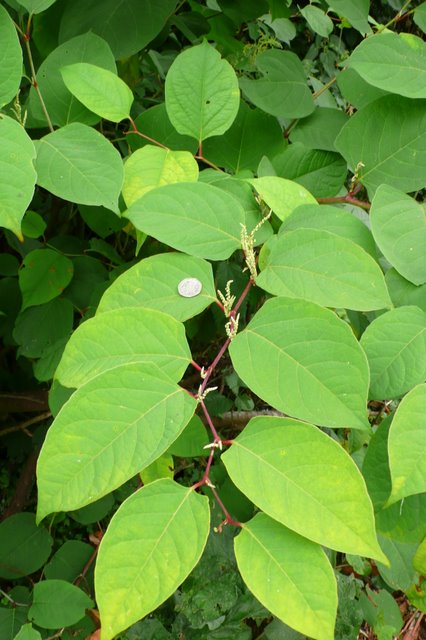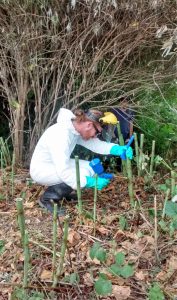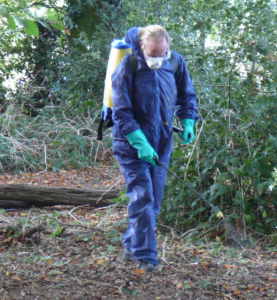Japanese Knotweed; What’s the big deal?
Japanese knotweed is a non-native invasive plant that was introduced from Asia as an ornamental plant. Knotweed spreads vegetatively and also sprouts from fragments of root and stem material, which are then dispersed by water, equipment or in fill. It can form fertile hybrids with giant knotweed. Some populations, particularly hybrids, produce fertile seed. Knotweed forms dense monocultures, with a thick layer of accumulated leaf and fibrous stem litter. A number of mechanisms contribute to its ability to exclude native species; light limitation, alteration in nutrient cycling and allelopathy—the ability to suppress growth of a potential plant competitor by releasing toxic or inhibiting chemicals. Knotweed can contribute both to stream bank erosion and to flooding, when its large, fibrous stems wash into the water during periods of peak flow. Its rhizomes and shoots can penetrate asphalt and cracks in concrete. It is most aggressive on sites with natural or human disturbance; stream and riverbanks, roadsides and construction sites. Japanese knotweed is therefore banned in the UK.
Identifying Japanese Knotweed
Japanese knotweed is a perennial, herbaceous shrub growing from 1 to 3 m (3-10 ft) in height. It has a deep taproot and an extensive network of rhizomes that may extend laterally from 7 to 20 m (23-65 ft). Its hollow stalks persist through winter and resemble bamboo.
Its leaves are simple, alternate and broad, typically growing up to 15 cm (6 in) long and 12 cm (5 in) wide. They have an abruptly pointed tip and a flat or tapering base. Its stems are upright, round, hollow, and often mottled, with a fine whitish coating that rubs off easily. Knotweed has numerous, small, creamy white flowers. They normally bloom in August and September and show signs of growth by March or April. Knotweed seeds are dark and glossy, and may be dispersed by wind, water, birds and insects.

idverde Management and Treatment of Knotweed
We offer a service both commercially and privately that aims to tackle Japanese Knotweed from the root, applying years of expertise and experience in this sector.
We will issue a site survey to record the extent of the infestation and list any physical restrictions on site. We would look to issue you with survey findings that are within a Knotweed Management Plan document.
The Knotweed Management Plan (KMP) would include details of relevant development proposals, remedial works feasibility (based on the survey, proposals for the site) and quotes for the remedial works, as well as a number of options to help you decide which method and cost suits you best.
The KMP can be a vital document to have to track remedial works that are undertaken, the records of these which would include any relevant details. This document is particularly important evidence if you are looking at a valuation of the land or property that has been affected by Japanese Knotweed. Please note that it can never be 100% guaranteed that Japanese Knotweed will always be completely eradicated, despite how successful any treatment has been.
Please contact us our team via email enquiriesbromley@idverde.co.uk for more details and rates. Include photos which would help us identify Japanese Knotweed.


